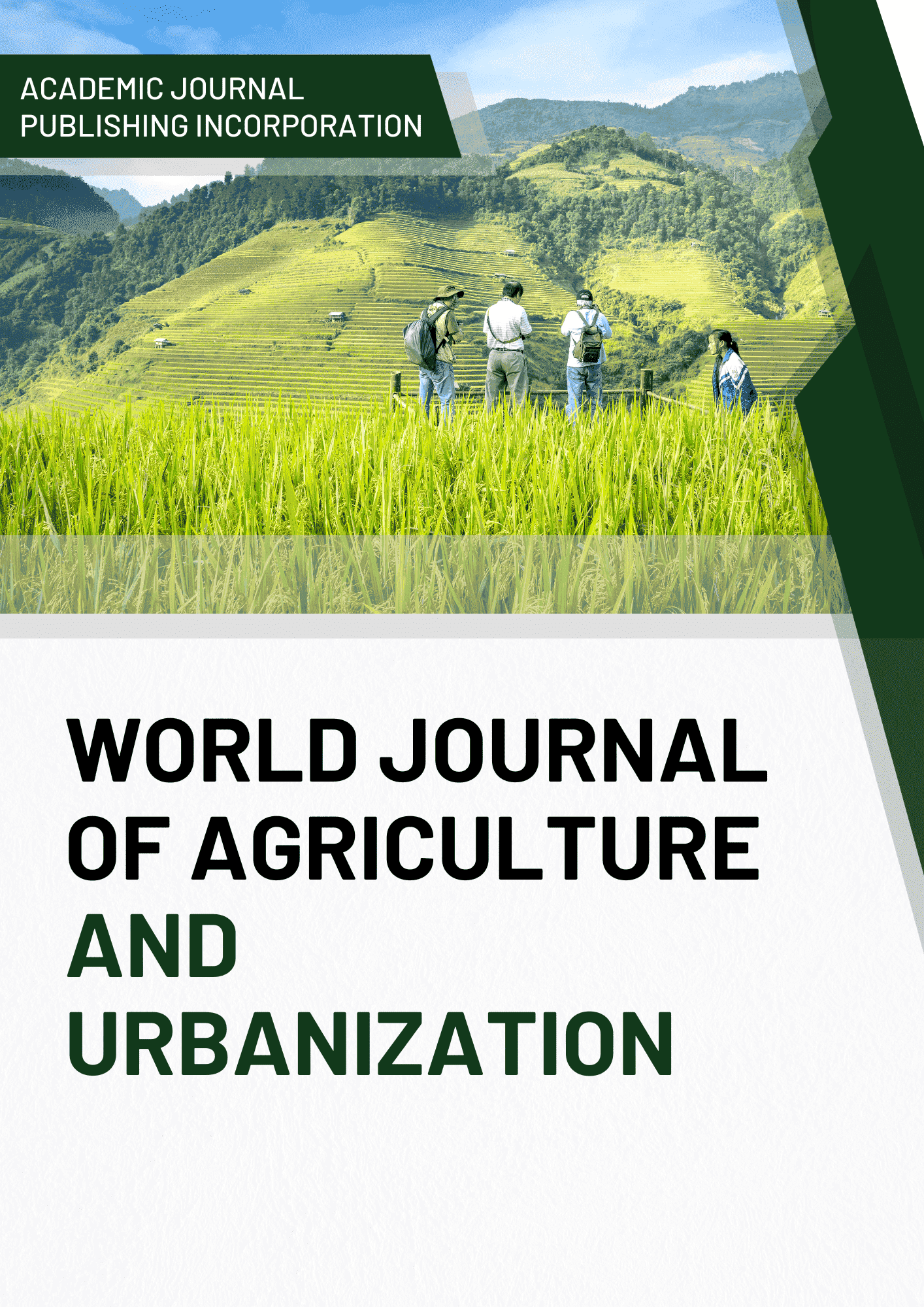Bioecological Features of Trematode Pathogens
Keywords:
fasciolosis, dicroceliosis, paramphistomatosis, orientobilgarciosis, L.truncatula, L.thiesseae, L.auricularia, L.bactriana, L.subdisjuncts, L.impuraAbstract
Prevention of the spread of fasciolosis, dicroceliosis, paramphistomatosis and oryentobilgarciosis among large and small horned animals in Uzbekistan based on bioecological features of pathogens and their transmission conditions, depending on the season. Emphasis is made on the epidemiological significance of fascioliasis and dicroceliosis, which can be transmitted to humans.
References
А. С. Даминов, К. Х. Уроков, "Роль брюхоногих моллюсков в эпизоотическом процессе фасциолёза и парамфистоматоза", International confernce on “agriculture, regional innovattion and international cooperation”, Samarkand-2017, с. 164-166.
Б. С. Салимов, З. И. Изатуллаев, Б. Хошимов, "Жигар трематодалари ва уларнинг оралиқ хўжайинларининг экологияси", Фарғона, 2006, с. 22-23.
А. С. Даминов, К. Х. Уроков, Н. И. Маматқулова, "Динамика распространения трематодозов и эхинококкозов в Самаркандской области", Анналы Румынского общества клеточной биологии, 2021, с. 5181-5185.
Т. Ф. Субботин and С. Т. Карелин, “Эпизоотология, течение и лечение при фасциолезе овец,” Ветеринария, 1979.
Ф. М. Биттиров, З. А. Сохроков, "Факторы становления пастбищных популяций фасциол", Ветеринарный вестник, М, 1999, №1, с. 118-120.
К. А. Буриев, "Динамика инвазированности моллюсков личиночными формами фасциол в хозяйствах Ферганской долины", Матлы науч. конф. “Возбудители и переносчики паразитов и меры с ними”, Самарканд, 1988, с. 43.
H. T. Boymurodov, A. S. Daminov, and K. X. Urokov, “Influence of aquatic environmental factors on the growth of shells of Sinanodonta gibba and Corbiculina ferghanensis species distributed in the aquatic …,” … University (Natural Sciences. Vol. 49. No …, 2022.
Б. С. Салимов, А. С. Даминов, Ш. Х. Қурбанов, "Қишлоқ хўжалик ҳайвонларининг жигар трематодозлари, уларни даволаш ва олдини олиш чора-тадбирлари", Тавсиянома, Тошкент, 2009, с. 28-29.
Б. С. Салимов, А. С. Даминов, К. Х. Уроков, "Қишлоқ хўжалик ҳайвонлари ва паррандалар трематодозлари", Монография, 2016, с. 58.
В. И. Здун, "Личинки трематод у пресноводных моллюсков Украины", Киев: Видово, 1961, 43 с.
З. И. Изатуллаев, Ж. А. Қудратов, "Шимолий Оқтоғ қориноёқли моллюскалари нинг биохилма-хиллиги хусусида илк маълумотлар", Гулистон давлат университети ахборотномаси, №3, 2017, с. 28-29.
М. И. Малкандуева, Эколого-эпизоотологическая характеристика F. hepatica Linnaeus, 1758 и фасциолеза овец в условиях Кабардино-Балкарии, пути регуляции …. elibrary.ru, 2011. [Online]. Available: https://elibrary.ru/item.asp?id=19265636
A. S. Daminov, K. X. Urokov, А. А. Nurullayev, and ..., “TREMATODALARNING ORALIQ XO ’JAYINI–QORINOYOQLI MOLLYUSKALARNING EKOLOGIYASI,” …, 2022, [Online]. Available: https://sciencebox.uz/index.php/tibbiyot/article/view/4382
А. С. Даминов, Ж. А. Қудратов, К. Х. Уроков, "Нурота тоғ яйловлари қориноёқли моллюскалари нинг тарқалиши ва чорвачиликдаги аҳамияти", Зооветеринария журнали-Тошкент, 2015, №4, Б.19.
А. С. Даминов, К. Х. Уроков, "Роль брюхоногих моллюсков в эпизоотическом процесса фасциолёза и парамфистоматоза", International conference on “agriculture regional innovation and international cooperation”, Samarkand, 2017, с. 164-166.
Т. А. Гинецинская, "Трематоды, их жизненные циклы, биология и эволюция", Москва: Наука, 1968, 411 с.
В. В. Горохов, "Эпизоотологический процесс при фасциолёзе", Ветеринария, 1986, №6, с. 38.
N. Peter, “Raccoons contraband – The metazoan parasite fauna of free-ranging raccoons in central Europe,” Int J Parasitol Parasites Wildl, vol. 20, pp. 79–88, 2023, doi: 10.1016/j.ijppaw.2023.01.003.
N. A. Younis, “Cyathocotylidae spp and motile aeromonads co-infections in farmed Nile tilapia (Oreochromis niloticus) causing mass mortality,” Microb Pathog, vol. 174, 2023, doi: 10.1016/j.micpath.2022.105897.
L. Bu, “A genome sequence for Biomphalaria pfeifferi, the major vector snail for the human-infecting parasite Schistosoma mansoni,” PLoS Negl Trop Dis, vol. 17, no. 3, 2023, doi: 10.1371/journal.pntd.0011208.
J. Koprivnikar, “Consumption of trematode parasite infectious stages: from conceptual synthesis to future research agenda,” J Helminthol, vol. 97, 2023, doi: 10.1017/S0022149X23000111.
R. Tidman, “Global prevalence of 4 neglected foodborne trematodes targeted for control by WHO: A scoping review to highlight the gaps,” PLoS Negl Trop Dis, vol. 17, no. 3, 2023, doi: 10.1371/journal.pntd.0011073.
M. Y. Pakharukova, “Opisthorchis viverrini, Clonorchis sinensis and Opisthorchis felineus liver flukes affect mammalian host microbiome in a species-specific manner,” PLoS Negl Trop Dis, vol. 17, no. 2, 2023, doi: 10.1371/journal.pntd.0011111.
D. C. G. Metz, “Potential for Emergence of Foodborne Trematodiases Transmitted by an Introduced Snail (Melanoides tuberculata) in California and Elsewhere in the United States,” Journal of Infectious Diseases, vol. 227, no. 2, pp. 183–192, 2023, doi: 10.1093/infdis/jiac413.
N. P. Reinhardt, “Helminths in Invasive Raccoons (Procyon lotor) from Southwest Germany,” Pathogens, vol. 12, no. 7, 2023, doi: 10.3390/pathogens12070919.
M. Y. Pakharukova, “Proteomic characterization of Opisthorchis felineus exosome-like vesicles and their uptake by human cholangiocytes,” J Proteomics, vol. 283, 2023, doi: 10.1016/j.jprot.2023.104927.
E. F. Fischer, “Occurrence of Gastrointestinal Parasites in Synanthropic Neozoan Egyptian Geese (Alopochen aegyptiaca, Linnaeus 1766) in Germany,” Diversity (Basel), vol. 15, no. 3, 2023, doi: 10.3390/d15030388.
A. Stanicka, “Friends or enemies: Multi-species interactions among biofoulers, endoparasites and their gastropod hosts,” Journal of Animal Ecology, vol. 92, no. 2, pp. 503–513, 2023, doi: 10.1111/1365-2656.13872.
S. D. Barata, “Molecular Diversity of Diplostomum spathaceum (Digenea: Diplostomidae) on the Capoeta umbla and Cyprinus carpio (Cypriniformes) Using Mitochondrial DNA Barcode,” Turk J Fish Aquat Sci, vol. 23, no. 1, 2023, doi: 10.4194/TRJFAS20576.
F. Formenti, “The Human Blood Fluke, Schistosoma mansoni, Harbors Bacteria Throughout the Parasite’s Life Cycle,” Journal of Infectious Diseases, vol. 228, no. 9, pp. 1299–1303, 2023, doi: 10.1093/infdis/jiad288.
Downloads
Published
How to Cite
Issue
Section
License
Copyright (c) 2024 Urokov K. H., Daminov A. S., Yunusov H. B., Nurullayev A. A., Taylakova M. Sh.

This work is licensed under a Creative Commons Attribution 4.0 International License.
The work simultaneously licensed under a Creative Commons Attribution 4.0 International License
You are free to:
- Share — copy and redistribute the material in any medium or format
- Adapt — remix, transform, and build upon the material for any purpose, even commercially.
The licensor cannot revoke these freedoms as long as you follow the license terms.
Under the following terms:
-
Attribution — You must give appropriate credit, provide a link to the license, and indicate if changes were made. You may do so in any reasonable manner, but not in any way that suggests the licensor endorses you or your use.
- No additional restrictions — You may not apply legal terms or technological measures that legally restrict others from doing anything the license permits.








